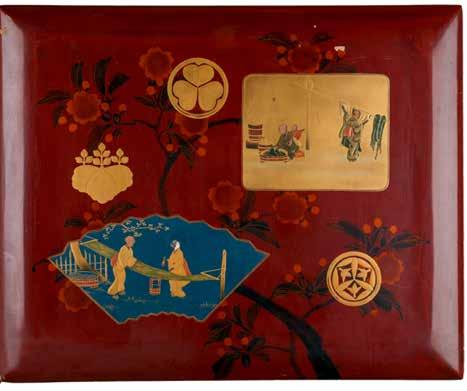Painting power and prestige: the shogun, daimyo and the Kanō school
Russell Kelty
For more than 400 years, the Kanō school of painters, based in Kyoto and Edo (Tokyo), created a definitive style of painting and a common visual language, which still resonates today. The remarkable longevity of the school ‘was the product of resourceful adaption to an ever changing landscape of patrons and prospects’.1 The school’s origin in the fifteenth century during the failing Ashikaga shogunate and subsequent commissions from prominent daimyo and temples in Kyoto allowed the establishment of numerous branches throughout the archipelago. The Kanō school flourished into the nineteenth century and remains the longest running and most influential hereditary assemblage of professional painters in Japan and is unique in world art history. Catering to the military elite, the Kanō painters used a combination of Chinese themes, bold brush-and-ink strokes, lush pigments and cut gold. This innovative style was intended to illuminate and embellish works initially intended to decorate temples and large castle interiors, with the aim of conveying a sense of grandeur and opulence. The artists of the Kanō school were not simply great painters but also connoisseurs who established collections from which to draw inspiration. Birds, tree and flowers is signed by the artist Kanō Sanraku (1559–1635) (fig. 1), a master screen painter who was an adopted fifth-generation Kanō school artist and founder of the Kyoto branch. It displays the graceful and refined flowing style that set him apart from his contemporaries. Painted late in Kanō Sanraku’s life, between 1624 and 1635, this sixpanel screen was most likely one of a pair and depicts the birds and flowers associated with late winter and early spring amid an expanse of cut gold leaf. On the left, an ancient willow tree extends its branches over a bamboo fence, while flowering camellias and young bamboo shoots, symbolising renewal and regeneration, indicate that spring is near. A white heron takes flight, while another rests on the tree – a staple motif in Japanese poetry and art, as herons evoke elegance and are often associated with winter. The extravagance of the cut gold contrasts with the dark blue stream, in which a solitary duck swims. The rock is a reminder that Chinese philosophical and cultural elements such as Daoism and brushand-ink painting had a profound impact on this school.
30
1 Yukio Lippit, ‘The Kanō school: the first hundred years’, in Felice Fischer & Kyoko Kinoshita, Ink and gold: art of the Kanō, Yale University Press, New Haven, 2015, p. 1.

















